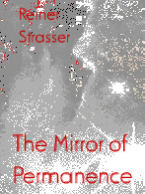|
Column for Rubric Material
**More about Marguerite Porete **Threaded voices **General Navigation |
Permanence NASA. The Structure and Evolution of the Universe: "Once a medium size star (such as our Sun) has reached the red giant phase, its outer layers continue to expand, the core contracts inward, and helium atoms in the core fuse together to form carbon [. . . .] Eventually, only about 20% of the star's initial mass remains and the star spends the rest of its days cooling and shrinking until it is only a few thousand miles in diameter. It has become a white dwarf. With no fuel left to burn, the hot star radiates its remaining heat into the coldness of space for many billions of years. In the end, it will just sit in space as a cold dark mass sometimes referred to as a black dwarf." (NASA, Quest I.) N. Katherine Hayles, leading hypermedia critic and author of How We Became Posthuman: "It is a stretch for computers half a decade old still to be able to function in the rapidly changing network ecology, but books can maintain backward compatibility for hundreds of years. A few years ago there was much talk about digitizing our libraries so we could fit them into a single room. Now it is becoming increasingly clear that if we really want something to last, the archival medium of choice is paper." (Hayles, e-mail to author) Nothing is permanent. Even things that seem nearly eternal to us, such as the universe, are engaged in a process of change and/or destruction. On the other hand, some time spans we perceive as very short - the life of a mayfly, a day at the circus. Marguerite of Porete believed that the material world was temporary, the world of the spirit, endless. Writers have tended to see their work residing in the material world. Within the notion of relative permanence, though, Porete and hypermedia writers do have a common concern with faith and time. If spirituality and art are sometimes linked, it is probably because they share an imaginative faith. This commonality of faith is the bridge between the idea and the reality, the concept and the creation, the anchor and the destination site. And the faith is linked to time. Artists may have different expectations about the time frame of their work - some believe it will last for centuries, a few hope it will outlive them, many wish to experience public acclaim, still others want merely to finish. Yet, in all creations, the imaginative projection of time, and the faith to realize the vision, are significant factors. For writers working on the edge of belief, or the edge of technology, risks abound. The field of hypermedia art and literature is so new that any commentary on it is tentative - we don't have a name for ourselves yet, and we don't have an agreed-upon terminology to discuss hypermedia fiction and poetry. No one is quite sure if we even have an audience. Moreover, hypermedia writing is very much in the experimental stages. I am acutely aware that I am not always successful in creating a complimentary blend of text, sound, and image - and I am grateful for suggestions and examples of others trying to solve similar aesthetic problems. Finally, the technology is complicated, and there are few models to follow. Some or all of these risks are typically present in the development of any new form. What is unique to electronic hypermedia is the instability of the platform itself. As faithful as they may be to their artistic vision, hypermedia writers are confronted with a speed-of-obsolescence factor that threatens to annihilate their work within years - if not months. Readers and critics may better understand the quixotic evolution of electronic literature and digital art when they consider that a hypermedia writer may not even be able to complete a piece before it is unreadable. Good. That established, let us talk about relative Impermanence.
Recto / Permanence / Impermanence / Alteration / Obsolescence / Obliteration / Verso
|
